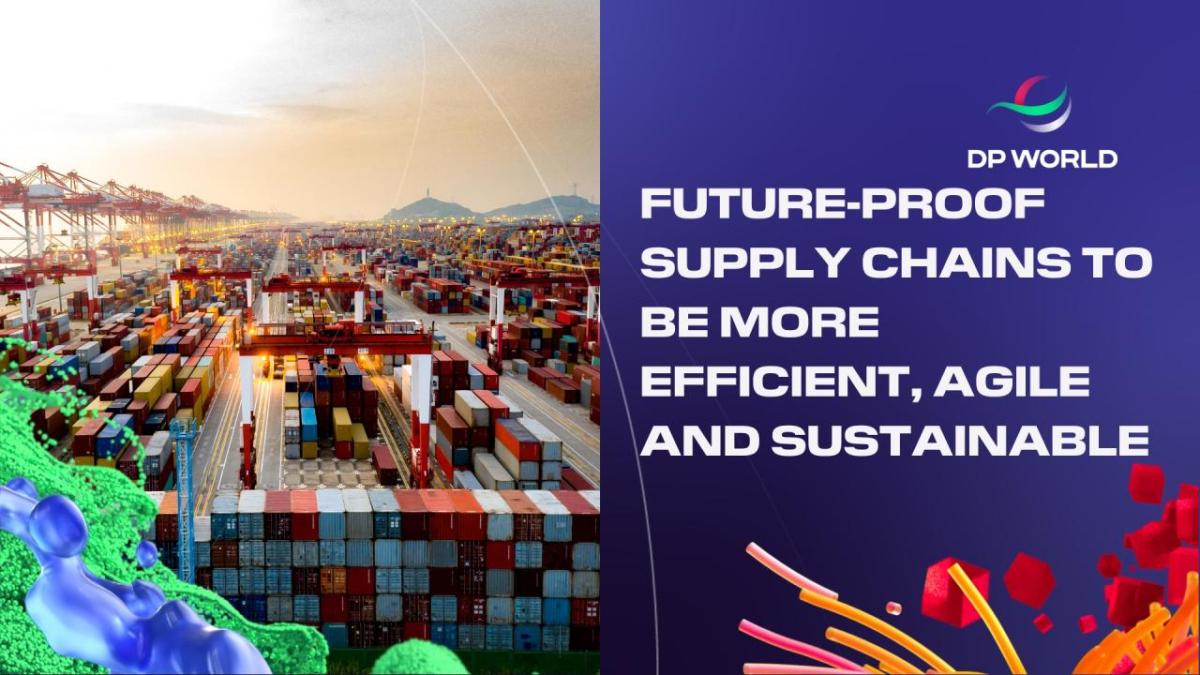Innovating for the Future: How to Future-Proof Supply Chains To Craft More Efficient, Agile and Sustainable Logistics Solutions
Supply chains have been rendered vulnerable in the wake of myriad ongoing challenges. What can they do to future-proof themselves?

As global supply chains continue to grapple with unprecedented challenges, the industry is being tested like never before. DP World and Supply Chain Dive’s studioID survey-driven report “Supply Chains Prepping for a Greener, More Agile Future” underlined the nature of these concerns. The report indicated that market variability, limited capacities for rapid adaptation and Environmental, Social and Governance (ESG) all top the list of concerns for logistics leaders.
Disruptions from geopolitical tensions are exacerbating supply shortages and inflating costs, while extreme weather events, ongoing cyber threats, and labor shortages compound the crisis. Natural disasters, from wildfires to floods, have delayed shipments, while regulatory pressures around sustainability and compliance continue to mount. These obstacles have had devastating consequences, causing delays, price surges, and operational inefficiencies that threaten the stability of even the most robust supply chains.
With such a perfect storm of risks, the question remains: How can supply chains future-proof themselves against these escalating threats and ensure resilience in the face of relentless disruptions?
1. Leveraging AI and Emerging Technologies
Deploying generative AI (GenAI) effectively throughout supply chains is key. According to Gartner Inc., GenAI is projected to power 25% of logistics Key Performance Indicators (KPIs) by 2028, helping companies automate and optimize everything from demand forecasting to route planning. By leveraging GenAI and machine learning, supply chains can analyze massive data sets, predict disruptions, and enhance decision-making. As McKinsey notes, during the pandemic in China, Nike used predictive-demand analytics and radio frequency identification (RFID) technology to reroute inventory and mitigate sales losses caused by store closures.
2. Building Resilience through Supplier Diversification
Diversifying supplier networks enables companies to mitigate risks from geopolitical conflicts, natural disasters, and supply shortages. The rise of nearshoring and friend-shoring, where businesses align with trusted partners in more stable regions, is helping to reduce reliance on single suppliers and vulnerable regions. For example, after the 2011 earthquake in Japan, Orkestra notes that Toyota revamped its supply chain, diversifying its suppliers to recover more quickly from subsequent disasters. According to a McKinsey survey, 60% of companies responding now report comprehensive visibility into their tier-one suppliers, though visibility into deeper tiers remains a challenge.
3. Strategic Inventory Management and Buffer Stocking
Strategic inventory management is another critical innovation that helps supply chains withstand disruptions. The just-in-time (JIT) model many companies relied on before the pandemic has proven vulnerable, leading to a shift toward maintaining buffer stock at critical points in the supply chain. For example, in response to tariffs and supply chain uncertainties, importers of semiconductors and electric vehicles have begun stocking up earlier to avoid shortages and manage costs more effectively (KPMG). While maintaining higher inventory levels can increase costs, it also ensures that companies can continue operations during supply shortages or price surges, helping to future-proof their supply chains against unexpected disruptions.
4. End-to-End Digital Integration for Real-Time Visibility
Digital integration across the entire supply chain is becoming essential for businesses aiming to improve operational efficiency and reduce risks. By connecting every link in the chain—from procurement to distribution—companies can achieve real-time visibility and anticipate disruptions before they escalate. Predictive analytics and Internet of Things (IoT) sensors provide insights into potential delays, allowing businesses to optimize routes and inventory levels. For instance, companies that have embraced integrated systems can track shipments in real-time, adjusting to tariff changes or natural disasters without significant delays. Moreover, businesses that adopt digital technologies to improve visibility and dynamic operations, as Capgemini observes, experience faster response times and more efficient supply chain management.
5. Sustainability and Circular Supply Chains
With rising ESG pressures, supply chains are increasingly focusing on sustainability initiatives. According to Xeneta, in Q1 2024, the global Carbon Emissions Index hit an unprecedented 107.5 points, an increase of 15.2% from 2023. In response, companies are adopting low-carbon carriers and sustainable procurement practices. Companies are also investing in green and circular supply chains, ensuring that sustainability is embedded across the entire value chain. For instance, according to McKinsey, following the implementation of digital twins to optimize energy consumption and reduce waste over the past decade, Henkel has cut energy use by 40% and waste by 20%.
By embracing these innovative approaches—AI, supplier diversification, strategic inventory management, digital integration, and sustainability—companies can future-proof their supply chains against the complex and evolving challenges of the global market. Each of these strategies not only mitigates risks but also enhances operational efficiency, positioning businesses for long-term success in an increasingly volatile world.
If you’d like to know more about what DP World and Supply Chain Dive’s studioID found in their report, “Supply Chains Prepping for a Greener, More Agile Future” click here to download a copy.

